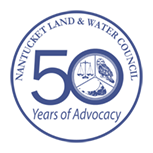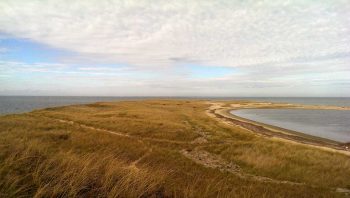The Nantucket Land & Water Council has been engaged in the health and protection of the island’s water since its beginnings. Through a variety of programs and partnerships the NLC continues to expand and diversify the data available to make sound policy decisions that will ensure the long-term protection of these precious resources.
Island Ponds Program
In 2009 the NLC supported surveys of Hummock and Miacomet Ponds conducted by Dr. Jim Sutherland and Dr. Sarah Oktay. This kicked off a new focus on Nantucket’s Ponds and the NLC’s Island Pond Program. In 2014 the NLC began sampling a subset of the island’s smaller ponds for which there is very little, if any, historic data. While the great ponds are well monitored by the Town of Nantucket, many of the smaller ponds and watersheds have not been studied. The ponds below have been sampled on a rotating basis, and the NLC hopes to add to this list in the future. Please click on the links below for results, to date, of this research.
Nantucket Water Health “Report Cards”
Nantucket Land & Water Council Water Reports use an index to measure the nutrient-related health of island water bodies. They provide a snapshot using monitoring data collected by the Nantucket Land & Water Council and analyzed in a laboratory. Each Water Quality Indicator is assigned a score from 100 to 0, with 100 being pristine water and 0 representing severe nutrient pollution. These “Report Cards” provide an annual check-up on the health of our ponds.
Capaum Pond Report Card
Individual Pond Reports (chapter excerpts from complete reports)
- 2020 Capaum and Gibbs Pond Report (PDF)
- 2018 Capaum Pond Report(PDF)
- 2015 Capaum Pond Report(PDF)
- Gibbs Pond – Coming Soon
- Little Weweeder Pond – Coming Soon
- 2014 Maxcy Pond Report(PDF)
- North Head of Long Pond – Coming Soon
- 2015 Pest House Pond Report(PDF)
- 2014 Tom Nevers Pond Report(PDF)
- 2014 Washing Pond Report(PDF)
Complete Pond Reports
- 2019 Island Ponds Report (PDF)
- 2017 Island Ponds Report(PDF)
- 2016 Island Ponds Report(PDF)
- 2015 Island Ponds Report(PDF)
- 2014 Island Ponds Report(PDF)
Phosphorous Sources for Hummock and Miacomet Ponds
In 2015 the Nantucket Land & Water Council partnered with the Nantucket Pond Coalition and the Town of Nantucket in a new study funded by the state and federal government through the Clean Water Act. This study was conducted on both Hummock Pond and Miacomet Pond throughout 2016 to determine whether elevated levels of Phosphorus are entering the pond via groundwater and stormwater from the surrounding watershed and/or if it is being internally recycled from sediments already in the pond. Read the 2016 Phosphorus Sources to Hummock and Miacomet Ponds Report.
Harmful Algal Blooms
The Land Council, through research and professional development at regional and national conferences has begun to take a closer look at the Harmful Algal Blooms (HABs) appearing in a number of our island ponds on a more frequent basis over the past ten years. HABs can be defined as an elevated concentration of algae that can negatively impact a water body or its uses. All HABs can depress oxygen, alter pH and contribute to the eutrophication of a system. While these algae blooms can occur in fresh or salt water and can be associated with any group of algae, the greatest risk comes from blooms of cyanobacteria (also known as blue-green algae) which are known to produce toxins harmful to the health of humans and animals (including dogs).
In 2020, the NLC continues its collaborative water quality work on Nantucket, with a more direct focus on two ponds- Gibbs and Capaum. Both have exhibited water quality conditions conducive to HABs, which can be toxic. Our research in 2020 will build on 2019’s research, helping the community better understand and enjoy these places as well as contribute to the world’s scientific understanding of Harmful Algal Blooms in general. We’re very excited to share this research with all of you as we go, so stay tuned!
Click here for more information on Harmful Algal Blooms (HABs) and our research.
If you would like to report on the condition of a pond or water body in your neighborhood you can keep the Town and conservation community informed using the NANTUCKET PONDS CONDITION SURVEY here created by the Nantucket Aquatic Threats Committee of the Nantucket Biodiversity Initiative, of which the NLC is a collaborator.
Groundwater Monitoring
Every month, NLC staff head out to ten designated sites on Nantucket to measure groundwater levels at observation wells installed by the United States Geological Survey (USGS). The USGS has over 7,000 observation wells across the United States which help us monitor our freshwater supply- arguably our most critical resource. This monitoring is even more important on our island, because our aquifer is what’s called a “sole-source” aquifer. This means that Nantucket has no reasonable alternative for a supply of freshwater should we use up, pollute, or otherwise destroy this one. The NLC has been monitoring these wells for the USGS since the 1980’s, providing data on the status of our aquifer for almost 4 decades. If you’d like to learn more about our sole source aquifer and how we monitor it, check out our virtual groundwater video!
National Atmospheric Deposition Program Station
NLC has been participating in the National Atmospheric Deposition Program for nearly a decade. This program includes automated collectors all over the country that collect and measure chemicals deposited by the earth’s atmosphere through precipitation including nitrogen, mercury, and ammonia. The organization’s work is important for our understanding of the environmental effects of things like acid rain and climate change. Our sampling station consists of a solar powered raingage and precipitation collector bucket which we sample every Tuesday, shipping a sample of Nantucket’s precipitation to Wisconsin for laboratory analysis. In October 2019, our sampling station was knocked out of commission when a storm knocked out the solar panel array powering the station. We are thrilled to report that with the help of Zach Dusseau at Ack Smart Energy, NLC’s NADP station is back up and running in 2020. Stay tuned for more news this season on the atmospheric data we’ve been collecting.
Other Water Research Publications
A list of all water reports and other Nantucket Land & Water Council publications can be found here.

